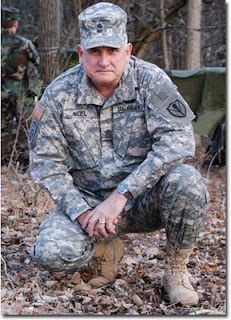It appears that one of the benefits of ridding the planet of the obnoxious Mr. bin Laden is that we can't go to our offices anymore without proving who we are every time we go into the building--the same building we enter every day, five days a week. Every day it's like we've never been there before and it makes not difference if we've worked in that building for 25 years. The elevated force protection measures in effect at DOD installations worldwide call for access to government buildings be granted only to those who possess a DOD-issued identification card.
This, er, precaution is believed necessary because an obnoxious devotee of the obnoxious religion of the obnoxious Mr. bin Laden might try to enter a government building and shout Islamic slogans. (He won't be able to blow anything up because the random searches of vehicles entering the installation would have caught the obnoxious devotee and his obnoxious contraband would have been confiscated; his only recourse, therefore, would be to enter government buildings and shout obnoxious Islamic slogans).
Of course that's never going to happen, but we're going to require an ID before we let you into your own workplace anyway. It's for your own safety.
Such is the thinking.
 |
| 100% ID Card Check |
I actually entered the building a few days ago and the female sergeant on duty never even looked at me. She only broke off her thoroughly engrossing conversation with her buddy to fain checking my ID's expiration date, then went back to her thoroughly engrossing conversation. I could have been Ayman al Zawahiri, for all she knew.
Like we (or even an obnoxious terrorist) would try to gain entry with an expired ID card! Have you any idea how much trouble it can cause you to try to access the network with an expired computer access card--a government ID card with an embedded microchip? Besides, using an expired ID is such an obvious, lazy way of gaining fraudulent entry. You can't tell that the NCOs have been instructed to check expiration date. I mean, they're not checking actual, authorized entry because they're not using access rosters. So your name means nothing. Only the expiration date on your card. They will physically stop you and will not let you pass without verifying that the government-issued ID in your possession is not expired ... even after the 10th or 20th time you've accessed the same building and have been checked by the same sergeant. If the ID card wasn't expired at eight in the morning, it's not going to be expired at lunchtime.
The stated intent of the ID card check is to prevent unauthorized entry to a government facility. I get that. What I don't get is that, after a month now, it's pretty obvious that the folks entering the building every morning (and then re-entering after leaving for a meeting, or for an appointment, or for lunch, for crying out loud!) are authorized. Re-checking their ID's expiration date only shows that you're too dumb to figure that out.
Not to impugn the professionalism of the NCOs required to pull card check duty. Like the female sergeant above, most of them figured out on about day #2 that checking expiration dates is silly. No one was any safer on any of the past 30 days because an NCO checked the IDs of everyone who entered the building. It's officers who dream up stuff like this.
It's small stuff, agreed, and shouldn't be "sweated." Still, it's so obviously a charade that it's insulting.
An obnoxious charade, at that.









